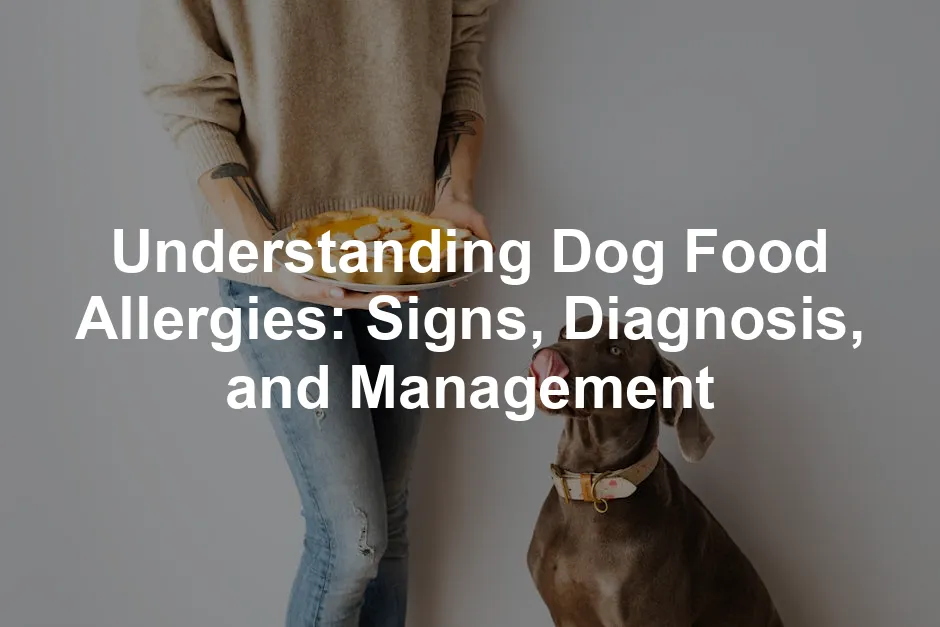Introduction
Dog food allergies are more common than you might think. They can significantly affect your dog’s health and overall happiness. Recognizing the symptoms early is crucial. If you suspect your dog has a food allergy, seeking veterinary advice is essential for proper management and care.
And while you’re at it, consider switching to a diet that supports your dog’s sensitive stomach! Hill’s Science Diet Adult Sensitive Stomach & Skin Dog Food is a great option to keep your furry friend happy and healthy!
Summary and Overview
Dog food allergies occur when the immune system mistakenly identifies certain food proteins as harmful. This differs from food intolerances, which do not involve the immune system. Common allergens in dogs include beef, chicken, dairy, and grains like wheat. Symptoms often include itching, gastrointestinal upset, and skin infections. Proper diagnosis and treatment are vital, as mismanagement can lead to chronic issues. Veterinary guidance plays a key role in developing an effective management plan for dogs with food allergies.
To help with dietary management, consider using Blue Buffalo Basics Limited Ingredient Diet Dog Food. It’s designed to minimize allergens while still keeping your dog satisfied!
Understanding and managing dog food allergies is crucial for the health of your pet. understanding and managing dog food allergies
Understanding Food Allergies vs. Food Intolerances
What is a Food Allergy?
A food allergy is an immune response to specific ingredients. When a dog consumes an allergenic food, their immune system reacts by producing antibodies. This can lead to a range of symptoms, including skin irritation and digestive problems. Food allergies can develop at any age, often after prolonged exposure to a particular food. In contrast, food intolerances do not involve the immune system and are generally less severe. While food allergies occur in about 10% of dogs with skin symptoms, intolerances are more common but less likely to cause severe reactions.
Common Food Allergens
The most frequent allergens affecting dogs include beef, chicken, dairy, soy, and wheat. These proteins often trigger allergic reactions. Regular exposure to these foods can lead to sensitivities over time. Less common allergens include lamb, fish, and certain grains. Certain breeds may be more prone to food allergies, such as Labrador Retrievers and Cocker Spaniels. Understanding these common allergens helps dog owners make informed dietary choices and avoid potential triggers for their pets.
If you’re looking for a specialized diet, Royal Canin Veterinary Diet Hydrolyzed Protein Adult Dry Dog Food is tailored to help manage food sensitivities with its hydrolyzed protein formula.

Symptoms of Dog Food Allergies
Common Signs
Dog food allergies can show up in various ways. The most frequent symptoms include itchiness, gastrointestinal issues, and skin infections. Dogs may scratch their ears, paws, and bellies, leading to redness and irritation. Gastrointestinal symptoms often manifest as vomiting or diarrhea, affecting about 20% of food-allergic dogs.
It’s important to note that symptoms can vary among individual dogs. While some might experience severe itching, others may show mild digestive upset. Studies indicate that around 10% to 15% of dogs with food allergies present both skin and gastrointestinal symptoms. The areas most commonly affected include the ears, paws, and belly. Infections may occur due to constant scratching, resulting in a cycle of discomfort and irritation.
Behavioral Changes
Food allergies can also lead to noticeable behavioral changes in dogs. Discomfort from itching or gastrointestinal upset can make a dog feel irritable or withdrawn. Many owners report that their dogs become less playful or more aggressive when in pain. This change in behavior can further impact the bond between you and your furry friend. Being aware of these behavioral signs is vital, as they often indicate that your dog is struggling with discomfort due to their food allergies.

Diagnosis of Food Allergies
Veterinary Consultation
Consulting a veterinarian is crucial for diagnosing suspected food allergies. A thorough history and clinical examination help identify patterns in your dog’s symptoms. Your vet will ask about your dog’s diet, symptoms, and any recent changes in behavior. This information is essential for guiding further diagnostic steps. Your vet may also recommend allergy testing or elimination diets to confirm the diagnosis. Early veterinary intervention can significantly improve your dog’s quality of life.
Elimination Diet Trials
An elimination diet trial is the gold standard for diagnosing food allergies. This process involves feeding your dog a special diet that excludes all potential allergens for 8 to 12 weeks. Common dietary options include hydrolyzed protein diets, where proteins are broken down to minimize immune response, and novel protein diets, which introduce a protein source your dog hasn’t eaten before.
Strict adherence to the diet is vital during this period. Even small amounts of treats or flavored medications can skew results. After the trial, your vet will guide you on reintroducing old foods one at a time to pinpoint allergens. Following this method can help you identify the exact triggers for your dog’s food allergies and inform their long-term dietary management.

Treatment of Food Allergies
Dietary Management
The main strategy for managing food allergies in dogs is avoiding allergens. This means identifying and eliminating specific ingredients that trigger their reactions. Prescription diets play a key role here. These often include hydrolyzed protein diets, where proteins are broken down into smaller components. This makes them less likely to provoke an immune response. Novel protein diets can also be effective. These diets introduce proteins your dog hasn’t had before, like duck or venison.
For a limited ingredient option, Merrick Limited Ingredient Diet Grain-Free Duck Recipe is a fantastic choice that can keep your dog satisfied without the common allergens!
Home-cooked diets are another option. Work with a veterinarian to ensure nutritional balance. Many store-bought foods labeled “limited ingredient” may still contain hidden allergens, so it’s crucial to choose carefully.
In summary, dietary adjustments are essential for effective management. Staying vigilant about food labels and ingredients helps create a safe eating environment for your furry friend.

Medication and Support
In some cases, medications may be necessary to manage symptoms. Antihistamines can help reduce itching and discomfort. Steroids may also be prescribed for severe reactions. However, these should be used cautiously due to potential side effects.
If your dog struggles with allergies, consider PetHonesty Allergy Support Dog Chews for a tasty way to help alleviate their symptoms!
Long-Term Management of Food Allergies
Long-term management of food allergies requires ongoing dietary adjustments. It’s important to monitor your dog closely for any new symptoms. Dogs can develop additional allergies over time, so vigilance is key. Regular consultations with your veterinarian can help you adapt the care plan based on your dog’s needs.
By keeping a close eye on your dog’s diet and health, you’ll be better equipped to manage their allergies. This proactive approach leads to a happier, healthier life for your furry companion.

Conclusion
Dog food allergies can be challenging for pet owners. Recognizing the signs and understanding how to manage these allergies is crucial for your dog’s health. Always consult your veterinarian for accurate diagnosis and treatment. They can help identify allergens and suggest appropriate diets.
And while you’re working on that, don’t forget to keep your dog entertained with a Dog Puzzle Toy to stimulate their mind while you manage their diet!
FAQs
What are the signs that my dog may have a food allergy?
Food allergy signs in dogs often include itching, skin infections, and gastrointestinal issues. You might notice your dog scratching frequently or having upset stomachs.
How can food allergies in dogs be diagnosed?
Diagnosing dog food allergies typically involves a veterinary consultation and an elimination diet. This method helps identify which food ingredients trigger allergic reactions.
Can dogs develop food allergies suddenly?
Yes, sudden food allergies in dogs can occur. A dog may react to a food they’ve eaten for years, as their immune system can change over time.
What should I do if I suspect my dog has a food allergy?
If you suspect food allergies, the first step is to consult your veterinarian. They can guide you through the steps for suspected food allergies, including dietary changes and tests.
Is there a cure for food allergies in dogs?
There is currently no cure for dog food allergies. The primary treatment involves avoiding the allergens that trigger your dog’s reactions.
What are the most common food allergens for dogs?
Common dog food allergens include beef, chicken, dairy, wheat, and soy. Each dog may react differently, so it’s crucial to identify their specific triggers.
Please let us know what you think about our content by leaving a comment down below!
Thank you for reading till here 🙂
All images from Pexels





